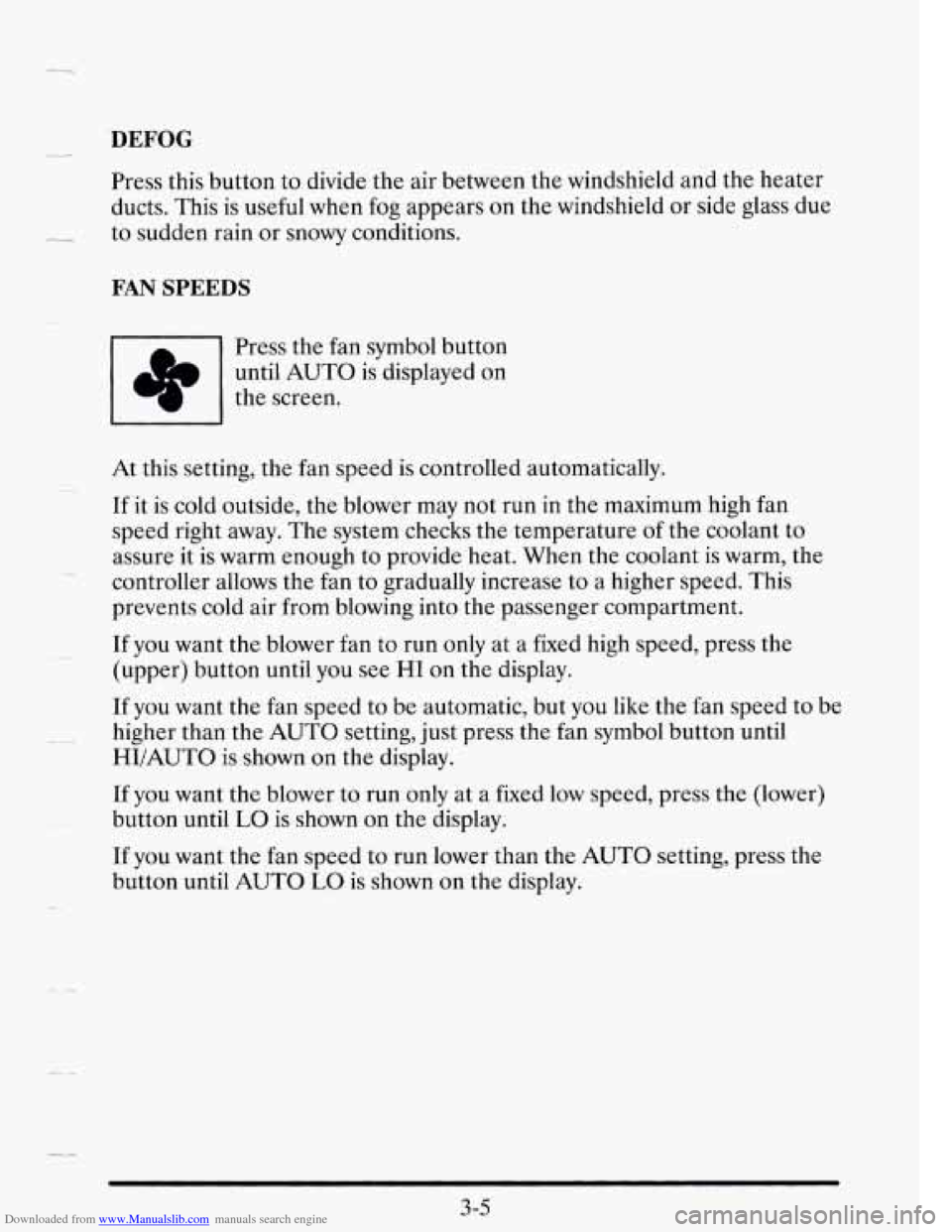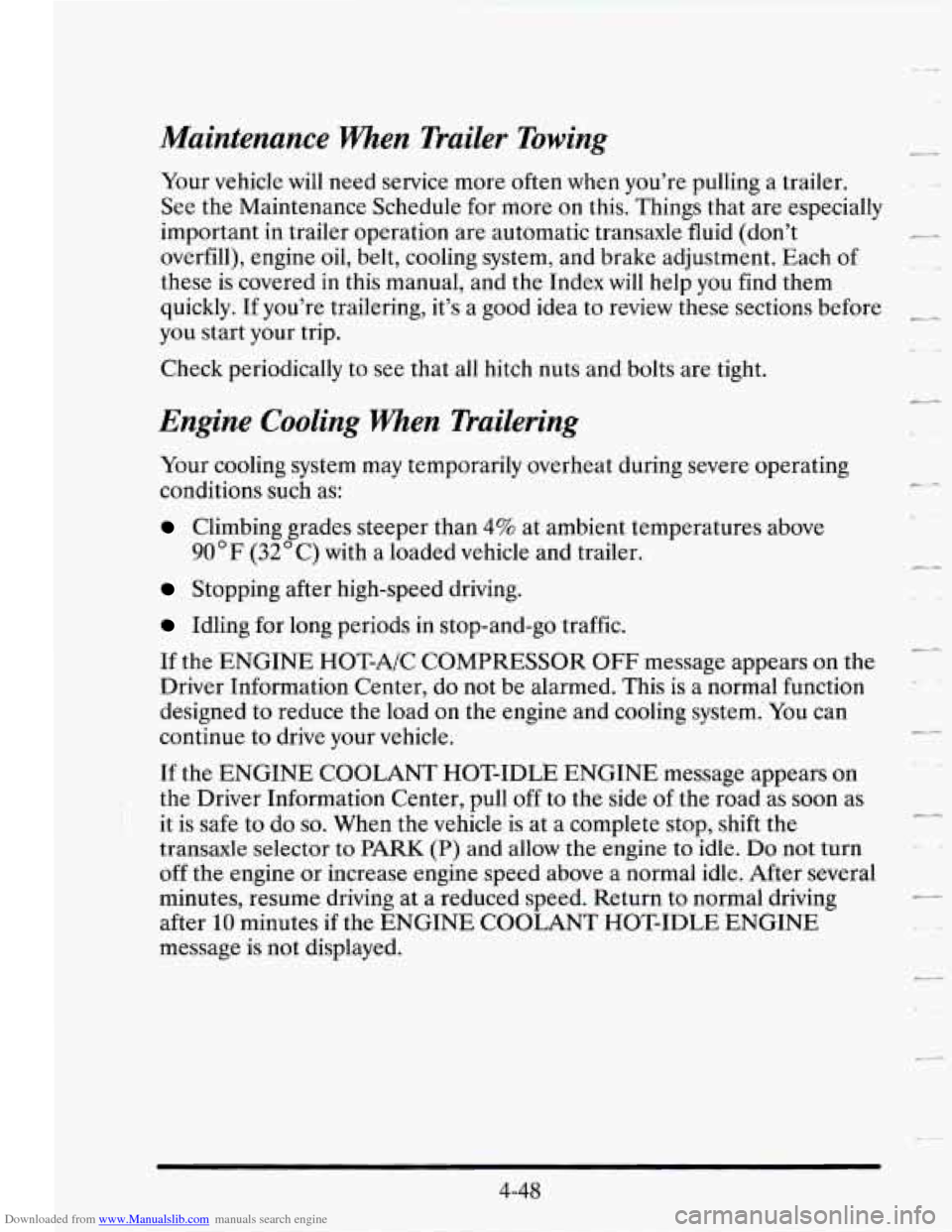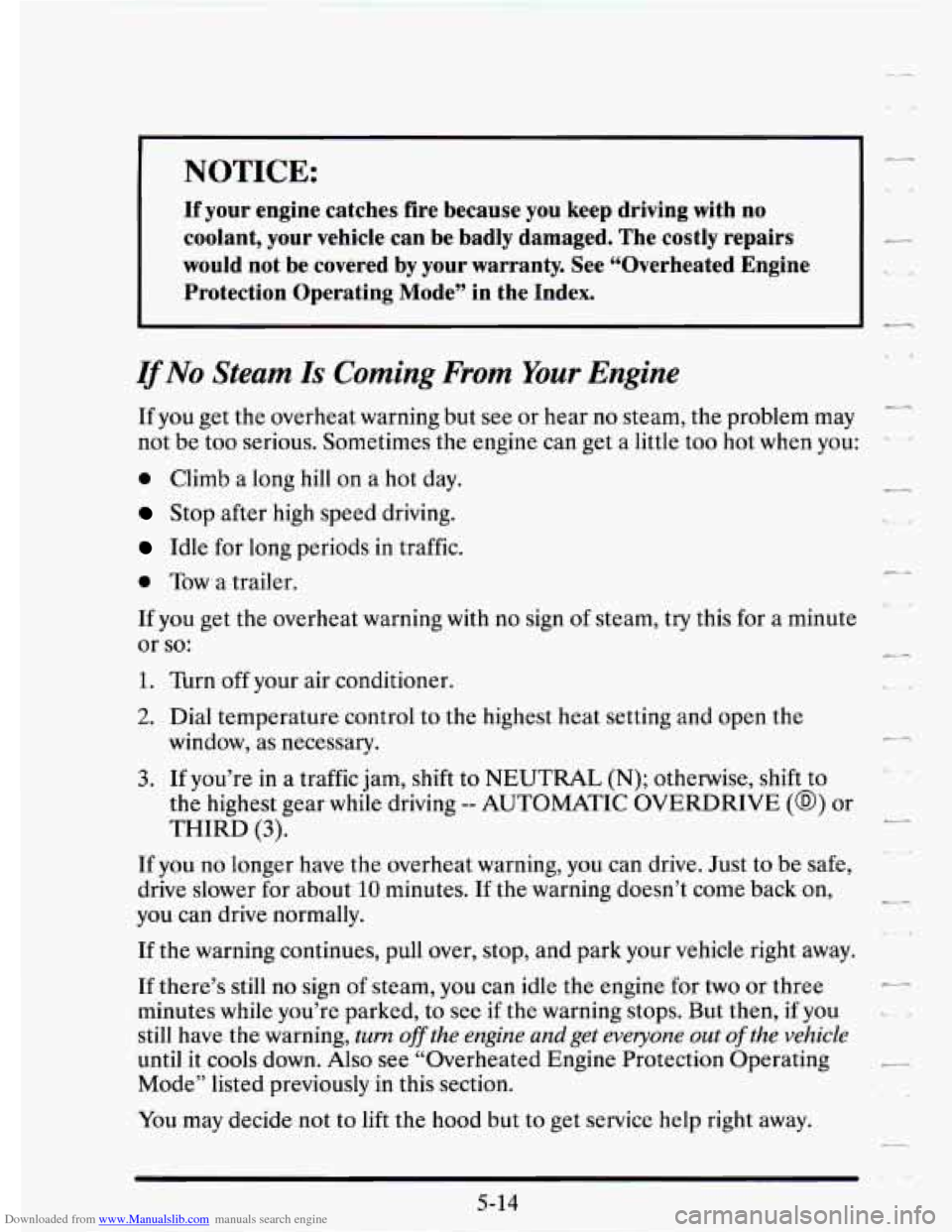Page 174 of 410

Downloaded from www.Manualslib.com manuals search engine DEFOG
Press this button to divide the air between the windshield and the heater
ducts. This is useful when fog appears on the windshield or side glass due
to sudden rain or snowy conditions.
FAN SPEEDS
Press the fan symbol button
until AUTO is displayed on
At this setting, the fan speed is controlled automatically.
If it is cold outside, the blower may not run in the maximum high fan
speed right away. The system checks the temperature of the coolant to
assure it is warm enough to provide heat. When the coolant is warm, the
controller allows the fan to gradually increase to a higher speed. This
prevents cold air from blowing into the passenger compartment.
If you want the blower fan to run only at a fixed high speed, press the
(upper) button until you see
HI on the display.
If you want the fan speed to be automatic, but you like the fan speed to be
higher than the AUTO setting, just press the fan symbol button until
HI/AUTO is shown on the display.
If
you want the blower to run only at a fixed low speed, press the (lower)
button until
LO is shown on the display.
If you want the fan speed to run lower than the AUTO setting, press the
button until AUTO
LO is shown on the display.
3-5
Page 222 of 410
Downloaded from www.Manualslib.com manuals search engine L- WINTER DmNG
Here are some tips for winter driving:
0 Have your Cadillac in good shape for winter. Be sure your engine
0 You may want to put winter emergency supplies in your trunk.
coolant
mix is correct.
4-3 1
Page 239 of 410

Downloaded from www.Manualslib.com manuals search engine Adahtenance When Trailer Towing
Your vehicle will need service more often when you're pulling a trailer.
See the Maintenance Schedule for more
on this. Things that are especially
important in trailer operation are automatic transaxle fluid (don't
overfill), engine oil, belt, cooling system, and brake adjustment. Each
of
these is covered in this manual, and the Index will help you find them
quickly. If you're trailering, it's a good idea to review these sections before
you start your trip.
--
Check periodically to see that all hitch nuts and bolts are tight.
Engine Coding When Trailering
Your cooling system may temporarily overheat during severe operating
conditions such as:
Climbing grades steeper than 4% at ambient temperatures above
90°F (32" C) with a loaded vehicle and trailer.
Stopping after high-speed driving.
Idling for long periods in stop-and-go traffic.
If the ENGINE HOT-A/C COMPRESSOR OFF message appears on the
Driver Information Center, do
not be alarmed. This is a normal function
designed to reduce the load on the engine and cooling system. You can
continue to drive your vehicle.
If the ENGINE COOLANT HOT-IDLE ENGINE message appears on
the Driver Information Center, pull
off to the side of the road as soon as
it is safe to do
so. When the vehicle is at a complete stop, shift the
transaxle selector to PARK
(P) and allow the engine to idle. Do not turn
off the engine or increase engine speed above a normal idle. After several
minutes, resume driving at a reduced speed. Return
to normal driving
after
10 minutes if the ENGINE COOLANT HOT-IDLE ENGINE
message is not displayed.
4-48
Page 251 of 410

Downloaded from www.Manualslib.com manuals search engine Don’t have your vehicle towed on the front wheels, unless you must. If the
vehicle must be towed
on the front wheels, don’t go more than 35 mph
(56 kmih) or farther than 25 miles (40 km) or your transaxle will be
damaged. If these limits must be exceeded, then the front wheels have to
be supported on a dolly.
ENGINE OVERHEATING
The Driver Information Center will display either ENGINE COOLANT
HOT-IDLE ENGINE
or STOP ENGINE ENGINE OVERHEATING.
In addition you will find the warning light about a hot engine
on your
instrument panel
on Canadian vehicles.
6-4
Overheated Engine Protection Operating Mode
Should a low coolant condition exist and the message STOP ENGINE
ENGINE OVERHEATING is displayed, an overheat protection mode
which alternates firing groups
of four cylinders helps prevent engine
damage. This operating mode allows your vehicle
to be driven to a safe
place in an emergency; you may drive
up to 50 miles (80 km). Towing a
trailer
in the overheat protection mode should be avoided.
5-12
Page 253 of 410

Downloaded from www.Manualslib.com manuals search engine NOTICE:
-
If your engine catches fire because you keep driving with no
coolant, your vehicle can be badly damaged. The costly repairs
I-
would not be covered by your warranty. See “Overheated Engine
Protection Operating Mode” in the Index.
I‘
lj?Nu Steam Is Coming From Your Engine
If you get the overheat warning but see or hear no steam, the problem may
not be too serious. Sometimes the engine can get
a little too hot when you:
-
0 Climb a long hill on a hot day.
Stop after high speed driving.
Idle for long periods in traffic.
0 Tow a trailer.
If you get the overheat warning with no sign
of steam, try this for a minute
or
so:
1. Turn off your air conditioner.
2. Dial temperature control to the highest heat setting and open the
window, as necessary.
3. If you’re in a traffic jam, shift to NEUTRAL (N); otherwise, shift to
the highest gear while driving
-- AUTOMATIC OVERDRIVE (@) or
THIRD
(3). -
If you no longer have the overheat warning, you can drive. Just to be safe,
drive slower for about
10 minutes. If the warning doesn’t come back on,
you can drive normally.
L
c4
If the warning continues, pull over, stop, and park your vehicle right away.
If there’s still no sign of steam, you can idle the engine for two or three
minutes while you’re parked, to see if the warning stops. But then, if you
still have the warning,
turn ofithe engine and get everyone out of the vehicle
until it cools down. Also see “Overheated Engine Protection Operating
Mode” listed previously
in this section.
You may decide not to lift the hood but to get service help right away.
5-14
Page 254 of 410
Downloaded from www.Manualslib.com manuals search engine ,-
- COOLING SYSTEM
- When you decide it’s safe to lift the hood, here’s what you’ll see:
- B. Electric engine fans.
A. Coolant surge tank with pressure cap.
5-15
Page 255 of 410
Downloaded from www.Manualslib.com manuals search engine 13
a
If the coolant inside the coolant surge tank is boiling, don’t do anything
else until it cools down.
The coolant level should be visible inside the surge tank once the cap has
been removed.
If it isn’t, you may have a leak in the radiator hoses, heater
hoses, radiator, water pump or somewhere else in the cooling system.
a
I NOTICE: I R
Engine damage if you keep running your engine without coolant
isn’t covered
by your warranty. See “Overheated Engine
Protection Operating Mode” in
the Index.
If there seems to be no leak, with the engine on check to see if the electric
engine fans are running.
If the engine is overheating, both fans should be
running. If they aren’t, your vehicle needs service.
a
5- 16
Page 256 of 410
Downloaded from www.Manualslib.com manuals search engine -- How to Add Coolant to the Coolant Surge Tank
If you haven’t found a problem yet, but the coolant level isn’t at a visible
level within the surge tank, add
a 50/50 mixture of clean water (preferably
the cooling system, including the coolant surge tank pressure cap,
is cool
before
you do it. (See “Engine Coolant” in the Index for more
information about the proper coolant
mix.)
- distilled) and a proper antifreeze at the coolant surge tank, but be sure
5-17